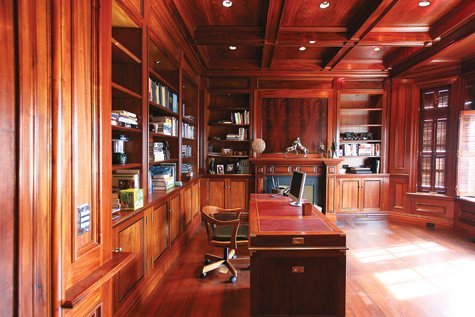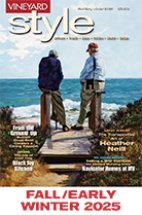ARTIST PROFILE

John Thayer
The Intricacies, Functional Wisdom and Art by Accident of a Master Cabinetmaker
By CK Wolfson
There is a kind of contagious comfort that quietly swirls around authentic and contented people — people like John Thayer. It’s actually relaxing listening to him talk about his business, his craft, and his working relationships. He has a knack for simplifying what might otherwise be complicated.
“It’s being vigilant and honest,” the 69-year old, master cabinetmaker says. He is explaining how he approaches his custom furniture and cabinetry business. But there are life lessons lurking in his messages. He adds, “It’s knowing what you need and what satisfies you.” Simple.
In 2018, Thayer celebrated his 50th year as a cabinetmaker, and he has learned what works best for him: being deliberate, not being impulsive about taking on clients, or custom jobs, and choosing “earnest people” as collaborators.
“When you begin, you meet the professionals you want to work with and build you relationships. At the end of every project you step back and say, ‘How did that work out for you?’”
He takes the same care with potential clients, admitting he interviews them as much as they interview him. “At this point, do I know who I want to work for? Yes. Do I have a good idea who I don’t want to work for? Equally yes — because you can only work for so many people, so why make it adversarial?”
And then, whether or not he realizes it, another life lesson: “What’s proven to be the best approach is seeing something for what it is, or for what it is not. It’s treating everybody honestly and not saying, ‘I am the one that you need.’”
Thayer encourages people to go elsewhere if they think someone else can do the work. “So if you come in for something you can probably get from Crate and Barrel, I’m the first guy who’s going to tell you to go to Crate and Barrel. But when you can’t find what you want, that’s when we’re going to have a conversation about what you need and see if we can help out. That’s our niche.”
He can afford to be selective about the jobs he accepts. He is successful — something he views with practical detachment. ”We’re pleased by [our success], but we work 55-hours, six-days a week. So we get the return on what we invest.” He shrugs, “You don’t get good at anything until you put the hours in — just put the hours in.”
He began working with wood when he was 19, moved to the Vineyard in 1976, and got a job at Martha’s Vineyard Shipyard doing boat construction and repairs. Eventually, he opened a furniture workshop in the family’s Vineyard Haven home and from there, the self-taught craftsman moved his business into a 2,000 square-foot section of the old 1940s boat shed in the boatyard on the west arm of Lagoon Pond. About 10 years ago, John Thayer Cabinet Makers LLC, designers and builders of whole house custom furniture and cabinetry took over the entire 3,000 square-foot workshop.
Steep, narrow steps lead to his small upper level office, so stripped-down it’s just a notch away from empty. He refers to it as “the employees’ lunchroom.” His sits at the small table in front of a window that boasts a view of the Lagoon estuary. Conversation stops while Thayer stares out at the boats, the pilings, the greens and blues, as if he were a painter memorizing the effects of light on the water. He mentions how much he appreciates the view on early mornings when he comes in. “We’ve been here 27-years,” he says, “and this is a great old building in every way.”
The open loft outside his office overlooks the work area and the rafters where lengths of wood are stored. When filled to capacity, extra wood and hardware are kept in eight-by-eight by 20-foot containers parked off the premises.
“It’s very difficult to find work space on Martha’s Vineyard, so every time we outgrow room we go into another storage container. We can’t expand the footprint of this building any more than we already have.”
In recent years he seldom deals directly with homeowners, and has almost completely stopped doing single-piece projects. Instead he works with interior designers, architects, and builders with whom he shares a long history. He has whole house projects around the country.
“I like unconventional needs, functions, design requirements. If we get an architect or designer to walk in the door and ask us to do something that stretches us out, to come in and say, ‘Oh, you don’t do that? Well, that’s exactly what I want,’ or ‘oh, you don’t like working with red oak? Well, I want this in red oak,’ and then we get excited about it.”
The “we” he refers to is a small team of five or six who have worked with him from four to thirty-five years — some second generation. Thayer smiles. “We’ve been working with the same people forever.” Everyone with his and her specialty, he says, all good at what they do, all working on different aspects of a project, and all able to offer ideas and solutions.
“Our hierarchy is horizontal, not vertical, and that’s a huge component in working with people. And that makes such a huge difference in how you work… It is shared work. I still need the help and ideas — even wrong ideas — in order to get where I’m going. No one is just a digit.”
As he talks, Thayer taps his computer and brings up different images of his work. He has just digitized 20 years of his designs and constructions. The screen fills with a photo of a room in a house that has been transformed into a lavish Old World style library, complete with curved walls and wooden trim. It is the result of year-and-a-half long project built in the workshop in 2008, and then installed in a home in Toronto, Canada.
A photo of a graceful three-legged demilune (half-moon) table comes up. A foot-and-a-half below the half-circle top is a curved shelf whose edge is inverted in curved arcs that match the arc of the table’s top.
“We tried for a long time to get a shelf that looked half-way decent, then suddenly we come up with this idea and it makes the piece.” His voice is enthusiastic: “It’s the favorite thing we’ve ever made,” he exclaims. “That’s where the accident comes in.”
Thayer calls it, “art by accident,” his favorite occurrence. It happens in a flash, when an unanticipated creative solution suddenly brings the design together in a striking new way. “I guess you say the sum becomes more than the parts,” he says. It is the jump-and-shout moment in his otherwise carefully planned process.
He recounts receiving a plan for a sofa table from a designer in Copenhagen, Denmark. Thayer interpreted the two lines representing the table’s top as a construction device, signifying a space, not intended to just indicate a measurement. So in building the table, he raised the top on ebony buttons slightly above its frame. The added half-inch of space made the top seem to float off the frame.
“When the designer comes in and sees it, he says, ‘What’s this?’ Then he shouts, ‘I love it.’” A broad smile spreads over Thayer’s face. “We agreed it was the best thing that ever happened. There’s the ‘accident.’ I think that table is one of my favorite things.”
One major change in Thayer’s long and steady-as-he-goes routine is the introduction of new electrical hand tools such as routers and lasers introduced in Europe. “Insanely great,” he declares.
Even more significant to his daily operation is learning to use Sketch-Up, a graphic modeling computer program that transforms two-dimensional renderings, into three-dimensional models.
“There’s no room for misunder-standing,” Thayer says, describing it as “the biggest advancement in concepts to construction drawing.” He says, “It’s new to me because I didn’t know it and resisted learning it. But there comes a point when you don’t have the time not to know it. So you have to step up and you’ve got to learn it. Everyday there’s something new to learn.”
He takes it all in stride. “You’re working on an extension table, one that people use twice a year when they don’t have enough room. It’s the exact same concept everyone’s working on — a leaf in the middle or leaf at the ends. Then, every once in a while you get a chance to do it in a way that’s a little more fun.” Thayer pauses. “But you’re still making an extension table.”
For more information contact: John Thayer Cabinetmakers, LLC., 100 Lagoon Pond Rd, Vineyard Haven, phone: 508-627-0618, johnthayer.com, john@johnthayer.com
“It’s being vigilant and honest,” the 69-year old, master cabinetmaker says. He is explaining how he approaches his custom furniture and cabinetry business. But there are life lessons lurking in his messages. He adds, “It’s knowing what you need and what satisfies you.” Simple.
In 2018, Thayer celebrated his 50th year as a cabinetmaker, and he has learned what works best for him: being deliberate, not being impulsive about taking on clients, or custom jobs, and choosing “earnest people” as collaborators.
“When you begin, you meet the professionals you want to work with and build you relationships. At the end of every project you step back and say, ‘How did that work out for you?’”
He takes the same care with potential clients, admitting he interviews them as much as they interview him. “At this point, do I know who I want to work for? Yes. Do I have a good idea who I don’t want to work for? Equally yes — because you can only work for so many people, so why make it adversarial?”
And then, whether or not he realizes it, another life lesson: “What’s proven to be the best approach is seeing something for what it is, or for what it is not. It’s treating everybody honestly and not saying, ‘I am the one that you need.’”
Thayer encourages people to go elsewhere if they think someone else can do the work. “So if you come in for something you can probably get from Crate and Barrel, I’m the first guy who’s going to tell you to go to Crate and Barrel. But when you can’t find what you want, that’s when we’re going to have a conversation about what you need and see if we can help out. That’s our niche.”
He can afford to be selective about the jobs he accepts. He is successful — something he views with practical detachment. ”We’re pleased by [our success], but we work 55-hours, six-days a week. So we get the return on what we invest.” He shrugs, “You don’t get good at anything until you put the hours in — just put the hours in.”
He began working with wood when he was 19, moved to the Vineyard in 1976, and got a job at Martha’s Vineyard Shipyard doing boat construction and repairs. Eventually, he opened a furniture workshop in the family’s Vineyard Haven home and from there, the self-taught craftsman moved his business into a 2,000 square-foot section of the old 1940s boat shed in the boatyard on the west arm of Lagoon Pond. About 10 years ago, John Thayer Cabinet Makers LLC, designers and builders of whole house custom furniture and cabinetry took over the entire 3,000 square-foot workshop.
Steep, narrow steps lead to his small upper level office, so stripped-down it’s just a notch away from empty. He refers to it as “the employees’ lunchroom.” His sits at the small table in front of a window that boasts a view of the Lagoon estuary. Conversation stops while Thayer stares out at the boats, the pilings, the greens and blues, as if he were a painter memorizing the effects of light on the water. He mentions how much he appreciates the view on early mornings when he comes in. “We’ve been here 27-years,” he says, “and this is a great old building in every way.”
The open loft outside his office overlooks the work area and the rafters where lengths of wood are stored. When filled to capacity, extra wood and hardware are kept in eight-by-eight by 20-foot containers parked off the premises.
“It’s very difficult to find work space on Martha’s Vineyard, so every time we outgrow room we go into another storage container. We can’t expand the footprint of this building any more than we already have.”
In recent years he seldom deals directly with homeowners, and has almost completely stopped doing single-piece projects. Instead he works with interior designers, architects, and builders with whom he shares a long history. He has whole house projects around the country.
“I like unconventional needs, functions, design requirements. If we get an architect or designer to walk in the door and ask us to do something that stretches us out, to come in and say, ‘Oh, you don’t do that? Well, that’s exactly what I want,’ or ‘oh, you don’t like working with red oak? Well, I want this in red oak,’ and then we get excited about it.”
The “we” he refers to is a small team of five or six who have worked with him from four to thirty-five years — some second generation. Thayer smiles. “We’ve been working with the same people forever.” Everyone with his and her specialty, he says, all good at what they do, all working on different aspects of a project, and all able to offer ideas and solutions.
“Our hierarchy is horizontal, not vertical, and that’s a huge component in working with people. And that makes such a huge difference in how you work… It is shared work. I still need the help and ideas — even wrong ideas — in order to get where I’m going. No one is just a digit.”
As he talks, Thayer taps his computer and brings up different images of his work. He has just digitized 20 years of his designs and constructions. The screen fills with a photo of a room in a house that has been transformed into a lavish Old World style library, complete with curved walls and wooden trim. It is the result of year-and-a-half long project built in the workshop in 2008, and then installed in a home in Toronto, Canada.
A photo of a graceful three-legged demilune (half-moon) table comes up. A foot-and-a-half below the half-circle top is a curved shelf whose edge is inverted in curved arcs that match the arc of the table’s top.
“We tried for a long time to get a shelf that looked half-way decent, then suddenly we come up with this idea and it makes the piece.” His voice is enthusiastic: “It’s the favorite thing we’ve ever made,” he exclaims. “That’s where the accident comes in.”
Thayer calls it, “art by accident,” his favorite occurrence. It happens in a flash, when an unanticipated creative solution suddenly brings the design together in a striking new way. “I guess you say the sum becomes more than the parts,” he says. It is the jump-and-shout moment in his otherwise carefully planned process.
He recounts receiving a plan for a sofa table from a designer in Copenhagen, Denmark. Thayer interpreted the two lines representing the table’s top as a construction device, signifying a space, not intended to just indicate a measurement. So in building the table, he raised the top on ebony buttons slightly above its frame. The added half-inch of space made the top seem to float off the frame.
“When the designer comes in and sees it, he says, ‘What’s this?’ Then he shouts, ‘I love it.’” A broad smile spreads over Thayer’s face. “We agreed it was the best thing that ever happened. There’s the ‘accident.’ I think that table is one of my favorite things.”
One major change in Thayer’s long and steady-as-he-goes routine is the introduction of new electrical hand tools such as routers and lasers introduced in Europe. “Insanely great,” he declares.
Even more significant to his daily operation is learning to use Sketch-Up, a graphic modeling computer program that transforms two-dimensional renderings, into three-dimensional models.
“There’s no room for misunder-standing,” Thayer says, describing it as “the biggest advancement in concepts to construction drawing.” He says, “It’s new to me because I didn’t know it and resisted learning it. But there comes a point when you don’t have the time not to know it. So you have to step up and you’ve got to learn it. Everyday there’s something new to learn.”
He takes it all in stride. “You’re working on an extension table, one that people use twice a year when they don’t have enough room. It’s the exact same concept everyone’s working on — a leaf in the middle or leaf at the ends. Then, every once in a while you get a chance to do it in a way that’s a little more fun.” Thayer pauses. “But you’re still making an extension table.”
For more information contact: John Thayer Cabinetmakers, LLC., 100 Lagoon Pond Rd, Vineyard Haven, phone: 508-627-0618, johnthayer.com, john@johnthayer.com








